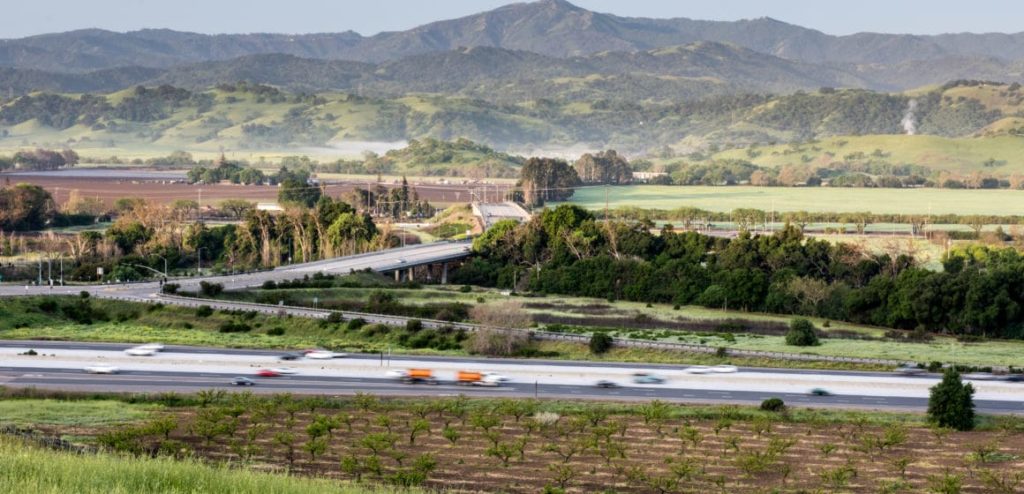Climate advocates and conservationists are praising Santa Clara County lawmakers for creating protections for one of the last green open spaces in the South Bay.
The Board of Supervisors voted last week to drastically limit development in Coyote Valley, preserving it for open space and agriculture and helping the region achieve climate change goals.
“I commit to working with our environmental partners to fairly compensate landlords for their land, then protecting that land with a permanent conservation easement, and selling that land to farmers with few resources,” Supervisor Cindy Chavez said in a statement.
The board established a maximum lot coverage of 7,500 square feet per acre for non-agricultural structures and will only permit new single-family homes on agricultural lots of more than five acres if they support farming activities. Supervisors directed staff to return in the spring with recommendations for how to create additional incentives and resources for small-scale farmers in the valley.
The county’s vote aligns with a similar step taken by San Jose in November to rezone 314 acres of Coyote Valley south of the city from industrial use to agricultural and open space. In 2019, the city approved $46 million to preserve 937 acres of Coyote Valley’s northern area.
Coyote Valley is considered one of the last undeveloped valley floors in California and is one of the only natural connections remaining between the Santa Cruz and Diablo mountain ranges. The valley is a vital source of drinking water for parts of the South Bay, and it reduces flooding in places like San Jose by absorbing rainwater.


Evolution of Coyote Valley
For decades, Coyote Valley was viewed as a future site for sprawling housing development and commercial operations, including tech campuses and industrial warehouses. Agricultural land has declined by 45% over the last two decades.
“We’re losing it not all in one go—we’re losing it as death by a thousand cuts,” Andrea MacKenzie, general manager for Santa Clara Valley Open Space Authority, told San José Spotlight.


The Open Space Authority and other organizations have already purchased land in the valley to set aside for conservation and agriculture. In November, the authority purchased 60 acres; earlier this year, the Peninsula Open Space Trust purchased 331 acres for more than $16 million. A coalition of groups paid $18 million for the 1,861-acre Tilton Ranch last year.
“What’s exciting about this action is both the city and county are saying it’s important to have a greenbelt and to maintain it,” Eli Zigas, food and agriculture policy director at SPUR, told San José Spotlight. “And that we don’t want to pave everything between San Jose and Morgan Hill.”
The board’s decision to safeguard farmland could shake things up for small-scale agricultural producers.
“The primary challenge to them is not whether they reach markets for their products… it’s whether they can have access to land,” Cayce Hill, executive director of community farm organization Veggielution, told San José Spotlight. “In particular with organic agriculture, having secure access to land is critical.”
There are still uncertainties about how agriculture and conservation spaces will intermix. Shani Kleinhaus, advocate for the Santa Clara Valley Audubon Society, said an endangered species—the tricolored blackbird—breeds in fields, including wheat and other staple crops. The group already has a program to pay farmers to delay harvests until baby birds have a chance to mature and leave the nest, and they’d like to see this expand.
“These are the kinds of programs we’d like to see in Coyote Valley—something that can help the farmers or ranchers or people who work the land, but also help wildlife recover,” Kleinhaus told San José Spotlight.
Some residents spoke out against the preservation proposal. Owners of plant nurseries raised concerns about the rezoning potentially limiting their operations. Some property owners also spoke out against protecting agriculture at the expense of development.
“Agriculture, specifically in the Coyote Valley, no longer works economically for most landowners,” said Roger Costa, a landowner, adding the area represents less than 15% of total agricultural output in Santa Clara County. “Please don’t sacrifice private Coyote Valley landowner interests on the altar of open space by only allowing agricultural zoning for privately held properties.”
The protections erected for Coyote Valley are novel not just in California, MacKenzie said. She believes the basic framework could be applied in other places, or at least used as inspiration by other jurisdictions to set aside undeveloped land for conservation and farming.
“Farther south in the county, (the) Morgan Hill and Gilroy areas still have a tremendous amount of prime farmland,” she said. “It’s really important that we not sprawl out onto that land.”
Contact Eli Wolfe at [email protected] or @EliWolfe4 on Twitter.



Leave a Reply
You must be logged in to post a comment.